Archive for August, 2008
August 24, 2008 at 10:38 am · Filed under Adventures, Travel / lifestyle musings
Our outing yesterday was up to Florissant Fossil Beds National Monument at 8400 feet altitude. It would have the highlight of today’s blog, because the fossils are interesting and there’s a lot of pleasant hiking to be done on a beautiful day. We got there in good spirits and started off on all the usual stuff, like the Junior Ranger program and the Ranger talk.
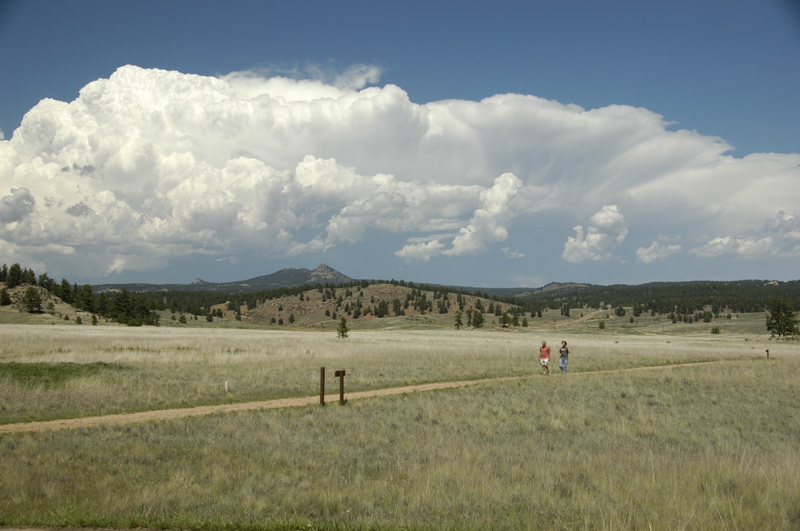
But huge thunderstorms began to arrive from the west, darkening the sky and suddenly our little 1-mile walk on the first trail was in danger of being rained out. The lightning was a bit threatening, but since it appeared to be 30 miles away, I wasn’t overly apprehensive.
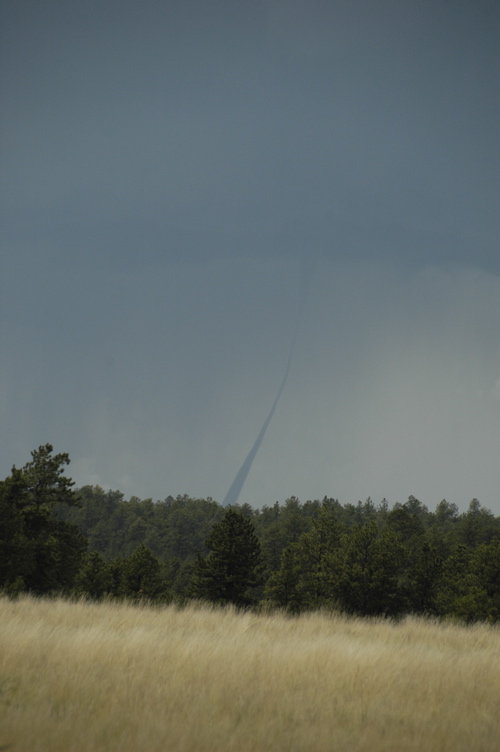
And then we crested a hill and I spotted this funnel cloud (click to enlarge). Suddenly the thunderstorms seemed a lot more interesting.
I’ve never seen a tornado before. My first thought was “Run back to the Visitor Center!” but my first action was to start taking pictures. These were taken at full zoom (200 mm). It hung out there for about a minute, not moving much, and then dissipated.
From that point on, Emma was pretty nervous, and we dashed through the rest of the exhibits on the trail. The enormous storms passed by to the north, giving us a spectacular lightning show but not much else.
Back at the Visitor Center, Emma finished up her Junior Ranger project and got her badge, and by that point more thunderstorms were bearing down on the area. The Rangers advised everyone to stay indoors rather than hiking. Since there was little chance of the weather improving in time for us to take a long hike, we bailed out and headed back along Rt 24 to Woodland Hill.
(For more photos from Florissant Fossil Beds National Monument, check my Flickr album.)




Tornado, going, going, gone, in less than a minute.
When we started out in the morning the temperature was about 75 degrees in Manitou Springs, and about 70 degrees at Florissant. With the arrival of the thunderstorms, the temperature dropped to 48 degrees. That swing tells you something about the power of these storms. Even back down at Manitou Springs (elev. 6320) it was only in the 60s.
The fast appearance and disappearance of the tornado reminded me of how many fleeting moments we have enjoyed in our travels. Many of those moments will never happen again, and I’m always glad when I can capture them with my camera and blog. You’ve got to seize the moment when you’ve got the chance.
Coincidentally, I got the news yesterday that the Sunshine Skyway Fishing Pier will close to RV traffic permanently starting August 29. The Skyway Pier has been one of our favorite places to camp. (We were last there on December 2006.) It’s a really unique experience, parked out there in the middle of the Tampa Bay, 20 feet above the sea all night. And now it’s over, forever.
I knew it couldn’t last. The great and unusual places to camp never do. There are few really interesting places left in this country where you can park for a night (outside of campgrounds, I mean), and they are dwindling away because of increasing property values, underfunded public agencies, encroachment, and busybody neighbors. In this case, the Skyway Pier was doomed by age and lack of funding. We’ll miss it.
If you find that really special place to camp, especially if it’s outside of the system, treasure it. Tell only people who can protect it (and be sure to tell me!) And keep your camera handy. You never know what might happen right in the middle of your walk in the park.
August 23, 2008 at 10:41 am · Filed under Maintenance
I mentioned in a previous post a couple of weeks ago in Ohio that we had a valve stem go bad on us suddenly. We were driving up I-270 in Columbus in moderately heavy traffic when suddenly the Doran 360RV tire pressure monitor started beeping.
 At the time I was curious why a valve stem would fail, and so I later inspected the remaining stems. It turns out that they dry-rot over time, and it really is good advice to replace them when you buy new tires. But of all the tire shops we have been forced to visit over the years, nobody has ever recommended new valve stems to us.
At the time I was curious why a valve stem would fail, and so I later inspected the remaining stems. It turns out that they dry-rot over time, and it really is good advice to replace them when you buy new tires. But of all the tire shops we have been forced to visit over the years, nobody has ever recommended new valve stems to us.
The only shop to replace a valve stem, to my knowledge, was the little local place in North Carolina where we had our most recent flat repaired. Instead of the all-rubber stems that came with our trailer, which are apparently best for low-pressure use, this shop put in a high-pressure valve stem (pictured at right). It’s more durable and flexes less. It’s also more appropriate for tires that run at 60-65 psi, like ours do. That was Stem #1.
When the valve stem failed in Columbus, I asked Airstream’s service center to replace it with a “metal” one. They did, but they took me literally and installed an all-metal stem. I should have asked for a “high pressure” stem instead. The metal stem is OK but it is a little longer than the others and that makes checking the tire pressure harder than it should be. That was Stem #2.
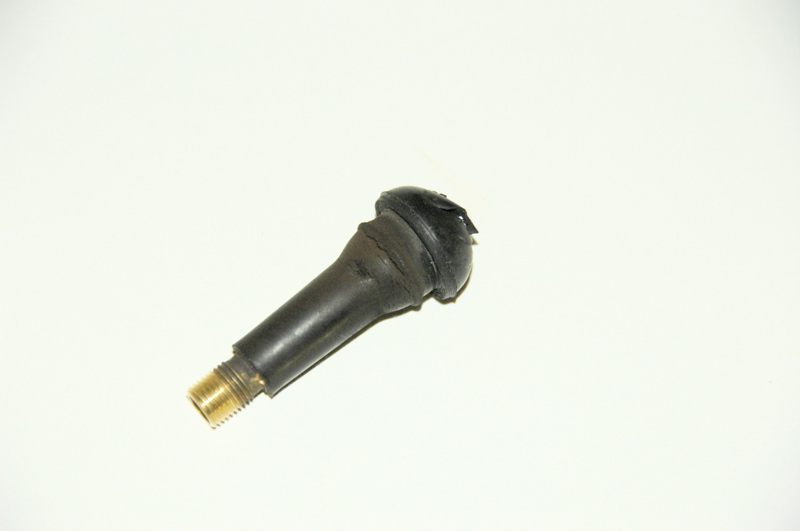 On the drive last week from Goodland KS to Aurora CO on I-70, the Doran started to beep again. Our left rear tire was running at 53 lbs. We aired it up at a truck stop and it seemed to be holding pressure, but I noticed that another tire’s valve stem looked very bad. That’s a picture of it at left. You can click on it to make it larger. Notice the extensive cracking around the base.
On the drive last week from Goodland KS to Aurora CO on I-70, the Doran started to beep again. Our left rear tire was running at 53 lbs. We aired it up at a truck stop and it seemed to be holding pressure, but I noticed that another tire’s valve stem looked very bad. That’s a picture of it at left. You can click on it to make it larger. Notice the extensive cracking around the base.
Now I was starting to get the picture. After some period of total neglect, our valve stems were gradually failing one by one. The shop in North Carolina noticed it and replaced one in May, then a second failed in Columbus in August, and now here was a third one needing replacement.
When we left Cherry Creek State Park yesterday, the Doran once again warned me of a low pressure tire. The same tire that had been low on I-70 was low again. It had lost 14 psi of pressure in five days. Clearly, we had a leak. I aired it up with my little 12-volt compressor and we drove down to Castle Rock (midway between Denver and Colorado Springs) and dropped in on a tire shop to have it checked. (Turned out to be a staple in the tire, fortunately patchable.) For the record, that’s our fourth incident of road debris penetrating a tire this year. While we were there, I asked them to replace the valve stem pictured above — #3.
The fourth one looks good for now — it may have been replaced in the past year by someone, I don’t know. But I’m going to replace it with a new high-pressure stem too, just to be sure. Should have done it yesterday, but for some reason the idea escaped me until we were departing.
The technician strongly recommended that we use nothing but “high pressure” valve stems in the future, and that we replace them every time we wear out the tires. Only problem with that is that we never seem to wear out tires anymore — they all get killed by road debris before they can wear out. So I’ll just make a point of having the stems replaced annually as we continue our Tour of America’s Tire Shops.
August 22, 2008 at 11:22 am · Filed under Tips & Ideas
The Democratic National Convention is driving us out of town. We didn’t realize when we booked our stay that the DNC was coming, nor the massive impact that it would have on everything near Denver. It is already nearly impossible to drive near the city, and things will only get worse when Sen. Obama shows up next week. All the state parks are booked solid this weekend, so we have to bail out today.
Otherwise we might have stayed another week. We’re always very comfortable in Cherry Creek State Park — it’s one of our favorite places to go. Not only is it a beautiful and super-convenient oasis right in the middle of Aurora, but we have lots of friends and collaborators in the area. If Airstream Life magazine had a fixed headquarters, it would be in Aurora CO. Three major contributors live here: Jody Brotherston, Fred Coldwell, and Forrest McClure. Many members and leaders of the Vintage Airstream Club are in Denver. TTT is in nearby Wheat Ridge. We’re near the center of the country, and the Denver climate is decent most of the year. This area has a lot going for it, Airstream-wise.
We caught up with Jody at her home on Wednesday night, for a superb dinner out on the patio, and saw Fred last night at a local Mexican restaurant near his home, too. Forrest is off on a caravan this week, so we couldn’t connect with him, but otherwise we’ve managed to do the rounds of business associates.
Brett flew home on Thursday, so the Airstream is now larger inside than it was. We had him with us for ten days, and it was a pretty good time all the way, despite the fact that he made us all sick. I suppose that’s a testament to our long friendship, because if it were anyone else we probably would have pitched him out somewhere in Kansas. As with all Airstream relationships, we don’t know when we’ll see him again, but we know we’ll see him someday.
I spent quite a bit of time yesterday morning developing a highly detailed trip plan for the next few weeks. In all our travels we’ve never researched and recorded such detail. But this trip is different from all others. In Utah, the parks are remote and resources are scattered. Internet, fuel, repairs, supplies — all will be sporadically available as we make the loop through Utah from Canyonlands to Capitol Reef to Bryce to Grand Canyon and finally to Page AZ.
Because I must work on some heavy projects in the next few weeks, I tried to work up a plan where we can alternately stop in a campground with connectivity to the Internet for a few days, and then disappear into a park for some hiking and exploring. It’s not a perfect plan, so we don’t have reservations and we are prepared to make sudden changes as events warrant. But Eleanor and I have a document on our computers now with phone numbers, addresses, resource notes, dozens of local maps, wifi locations, recommended campgrounds, Ranger programs, fuel locations, operating hours, and many other details for each stop. It should be enough to allow us to fumble through Utah for a few weeks.
The Internet, as always, has been instrumental to my research. I usually have four or five browser windows open simultaneously as I plan (as well as a paper map). My favorite sites for trip planning include:
National Park Service: great info on every national park site. This is the first place to go when planning a park visit.
RV Park Reviews: If you need a campground outside the national park, this site gives you great info from people who have been there. Be aware that the price other people paid isn’t what you might pay, so be sure to visit the specific campground’s website as well.
RV Dumps: Good for finding dump stations along the route, if you are going from one extended boondocking (or courtesy parking) situation to another. Most dump stations listed here are along highways but sometimes in small towns.
Google Maps: Excellent trip mapping tools. You can grab the route suggested and drag it on the screen to explore alternate routes.
Recreation.Gov or ReserveAmerica: These are both powered by ReserveAmerica, and are THE way to make online reservations for most national and state parks.
Bureau of Land Management: If you are traveling in the western states, you’ll find some sites are BLM rather than NPS. This includes places like Grand Staircase-Escalante National Monument. The BLM site is not easy to navigate, but click on a state and then on a region and you can fumble your way through to the place you’re interested in. BLM also operates a lot of primitive campgrounds that are free or very cheap.
There is so much in Utah to do that I have been forced to trim several places from the trip plan. Vermillion Cliffs NWR is going to be saved for another trip. It’s a massive hiking destination and deserves a couple of weeks all by itself. We may have to skip Canyon de Chelly, Rainbow Bridge, and Navajo too. The White Mountains and Monument Valley in northern AZ may get skipped if work starts to become an issue, but we can get back up there from Tucson pretty easily. It pains me to pass by great spots like these, but I also don’t want to blow through them in a hurry.
Instead, we’ll concentrate on Canyonlands, Capitol Reef, Bryce, and Grand Canyon’s north rim. Even still we’re not giving them their due, but I am hoping 2-5 days in each will be enough to at least get to know them a little and plan a follow-up trip another year. If we find one park we particularly like, we may stay much longer, which is the major reason why we aren’t making reservations right now. Instead, we’ll make reservations every week for the next week’s stops.
While work is a huge factor right now, the other deadline is the season. September is a great time to be in these parks, which run from 4,000 to 8,000 feet in elevation. But by mid-October things will be quite different. Campgrounds will start shutting down and, nights will be close to freezing, and sunsets will be very early. I think we’ll want to be moving to lower elevations in October, below 4,000 feet.
That still leaves the possibility of Canyon de Chelly, Navajo, Wupatki, Sunset Crater and other spots, so it’s not a hard deadline, just something to keep in mind. In the west, weather is not determined by latitude as much as altitude. (Having a topographic map would have been extremely useful in this trip planning process, and if I find a good one for southern UT and northern AZ during our travels I will probably buy it.) When things really start to get chilly, we’ll be in Tucson at 2,000 feet, settling into our winter home base.
August 20, 2008 at 6:03 pm · Filed under Roadtrips, Travel / lifestyle musings
We’ve been pondering the choices ahead, and have made some decisions. Mostly, we’ve decided that the opportunity to go explore a bunch of the country’s best national parks in late August and September is too much to miss. The Four Corners region is one of the most densely packed areas of national parks, and some of the most famous and beautiful ones are here. We don’t know when we’ll get this chance again.
If we head straight back to home base, we’ll have about 850 miles to drive and we’d see maybe three or four great spots along the way. But if we take a convoluted route of about 1,500 miles through southern Colorado, Utah, and northern Arizona, things get considerably more interesting. We will get to visit:
- Great Sand Dunes National Monument and Preserve
- Mesa Verde National Park
- Hovenweep National Monument
- Yucca House National Monument
- Natural Bridges National Monument
- Canyonlands National Park
- Capitol Reef National Park
- Bryce Canyon National Park
- Grand Canyon National Park (north rim) (Not shown on route map)
- some of Monument Valley
- Navajo National Monument
- Canyon de Chelly National Monument
- Petrified Forest National Park (previously visited)
- the White Mountains of northern Arizona
The added mileage will cost about $300 in fuel. We’ll also spend about $400 in additional campground fees. For that we’ll get four or five weeks of travel through 11 national parks. That’s a heck of deal for $700. Since we are spreading the cost out over a month, we can afford it more easily. It’s about $20 per day.
The real consideration is keeping up with work. The western national parks are generally out of range of cellular Internet and voice. A few campgrounds have wi-fi (which we know from past experience is unreliable), and a few spots can be reached from towns with cell phone service like Cortez CO. We’re going to have to juggle work and play carefully.
The idea is one we’ve used all along. When things are quiet, we scoot into a national park and drop off the network for a few days. Then, we drive to the nearest place where I can get online and Eleanor can catch up on groceries, laundry, etc., and settle in for a few days of work and homeschooling. Three or four days later, we move on to the next remote park and repeat. The challenge in the four corners region especially is that there’s a lot more “remote” territory than anything else.
It’s also much more expensive to park in a wi-fi enabled campground than in the national park campgrounds we favor, usually by a factor of two. Since we are trying to compensate for higher fuel prices, we’ve been tending to free and cheap campsites more than usual. The work periods will drive up our expenses. That’s a good motivator for me to get the jobs done as quickly as possible. Efficiency pays when you’re working and full-timing.
With all these competing factors, we can’t say we have a firm plan, only a route and a set of guidelines. So we can’t make reservations. We’ll just have to wing it, as usual. Sounds like fun to me.
August 20, 2008 at 12:31 am · Filed under Places to go
Our big trip for today was out to Wheat Ridge, CO, where Timeless Travel Trailers is based. They’re a relatively new advertiser in Airstream Life magazine, and Brett and I wanted to check out the operation. We’d heard very good things about them from the Airstream folks in Jackson Center.
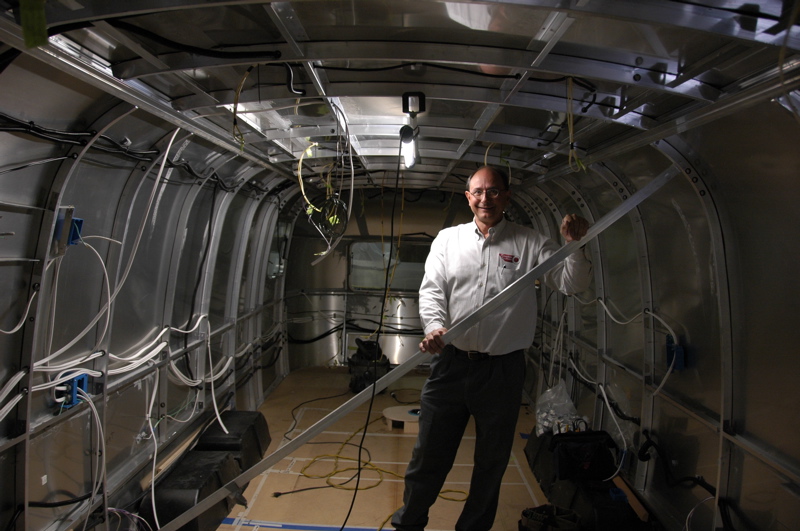 We were extremely impressed. They’ve got 30 people working in two buildings, cranking out two completed trailer projects each month. The staff includes two full-time designers, an estimator, and a couple dozen craftsmen in various specialty areas. The head of the operation, Brett Hall, gave us a tour of the facility and then sat down with us over lunch to talk about the industry.
We were extremely impressed. They’ve got 30 people working in two buildings, cranking out two completed trailer projects each month. The staff includes two full-time designers, an estimator, and a couple dozen craftsmen in various specialty areas. The head of the operation, Brett Hall, gave us a tour of the facility and then sat down with us over lunch to talk about the industry.
TTT is on the way to becoming the official builder of custom Airstreams. Right now, Airstream doesn’t normally sell trailer shells, for lots of reasons. TTT has been allowed to buy a few direct from the factory for customization, and if all goes well they’ll formalize the relationship with Airstream and be the only shop in the country allowed to build custom Airstreams from new shells. The photo at left shows a new 31 foot Airstream shell in which TTT staff have begun to run wiring for a client.
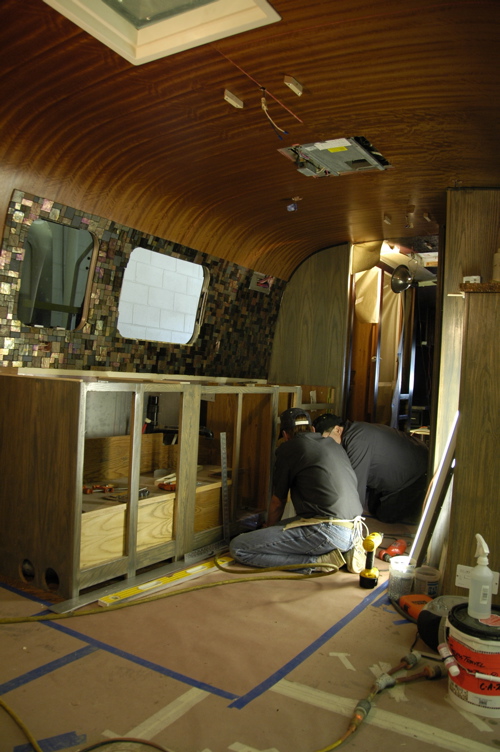 TTT also rebuilds vintage and late model Airstreams for customers. There were about six projects in the shop when we arrived, each one being renovated at a fantastic pace. The 34-footer in the photo at right as been in the shop for five weeks and will be done in one more week. The customizations run from about $50,000 up, with many projects exceeding $100k.
TTT also rebuilds vintage and late model Airstreams for customers. There were about six projects in the shop when we arrived, each one being renovated at a fantastic pace. The 34-footer in the photo at right as been in the shop for five weeks and will be done in one more week. The customizations run from about $50,000 up, with many projects exceeding $100k.
I love visiting my advertising clients because they all have interesting stories to tell, and interesting businesses. In the past week we’ve been to see Airstream, Bill Thomas Camper Sales, and Timeless Travel Trailers. All of them have been completely different, but share a common excitement for the product and the lifestyle it enables.
This evening’s entertainment was bowling downtown at Lucky Strike Lanes with Brett G’s sister, who lives in Denver. Emma loves bowling, and it seems to be something everyone can enjoy, even the lousy players. (Tonight I was the lousy player for some reason.)
Brett G is spending the next couple of nights at his sister’s house, so our Airstream is a bit emptier than it has been lately. We’re gearing up to get back into our usual 3-person travel mode. I’ve finally made plans for our weekend (Colorado Springs), and we have a tentative plan for the next couple of weeks. Thanks to everyone who suggested their favorite national park in Utah — we plan to take that advice soon.
August 18, 2008 at 11:03 pm · Filed under Uncategorized
We’re back in a favorite spot, Cherry Creek State Park in Aurora, CO, with all eight wheels parked on the pink concrete. I’ve spent the day digging through work tasks that fell by the wayside last week, and slurping down all kinds of fluids to fight the cold. Recovery is not far away, thankfully.

Emma enjoys a movie on the laptop, in our bed, on a rainy Sunday morning in Goodland KS
There was a cold rain in Goodland KS when we left, and it continued occasionally along I-70 through Colorado, leading me to wonder if we would ever escape the rain. These are dry areas, normally. But it was just a reminder of the weather we have finally left behind. Today Aurora has bloomed into sunshine and 82 degrees, without a trace of precipitation in the week’s forecast.
It’s time to regroup a bit. We’ve got more meetings this week before Brett flies home to Florida (to see if his home is still standing after Hurricane Fay). But mostly I’ve got to put things in order, on the business and personal side. For this reason, and to recover comfortably from the cold, I set up the Official World Headquarters of Airstream Life magazine on the queen bed, and parked myself for the day.
One task is to figure out where we are going next. The firm plan only extends to this weekend; after that it’s just a series of vague ideas. Generally speaking we were going to head to southern Colorado and visit some national parks, ending up at Mesa Verde and then moving into Utah. This still sounds good, but work has begun to intrude. I’m starting some new projects (in addition to working on the Winter 2008 magazine), which requires me to spend a lot of time where I have reliable cell phone and Internet access. The timing isn’t good to go wandering around remote parts of Utah.
But I hate to cut the trip short. We are 15 hours drive from home base, and if we head back now it will be a while before we are ready to make the trip back up the Utah. Tough call. I’ll be looking for some compromise plan this week. We might pick just one major national park in Utah, but which one? They’re all great.
August 16, 2008 at 9:24 pm · Filed under Roadtrips
I suppose if I must have a cold while trying to cross a broad swath of the USA, Kansas is a good place to have it. That’s because I can never equalize my ears when I have a cold. Nothing works for this problem, including medications and various techniques used by divers. So typically a cold means I am restricted to one elevation until it clears up, and absolutely no flying.
Fortunately, the drive east to west across Kansas is a gentle rise most of the way. We pulled out this morning from our quiet and scenic spot by the lake near Baldwin City at about 1,600 feet elevation, and eventually ended up here in Goodland at 3,700 feet. That climb — if you can call it a climb — was spread over about 300 miles, or about 3.6 feet elevation gain per mile. Nice and gradual, and easy on the three people in the car who have colds at the moment.
Yes, now there are three. Emma started having symptoms last night. Only Eleanor has so far escaped the viral wrath from Florida. After two long days in the car I thought Emma would appreciate a short day today, with lots of breaks to run around, but when she got the cold we changed the plan. There’s nothing like a virus to take the edge off a kid. She was happy to spend most of the time sitting in the car playing with her toys, and I was happy to have Brett as chauffeur for most of the day.
Goodland is a nice place to stop along I-70. We’ve been here before. The town is big enough to have good services, and small enough that there’s not much traffic. Since we have only 200 miles or so before Denver, we’re going to spend sometime here on Sunday to explore the various sights in town.
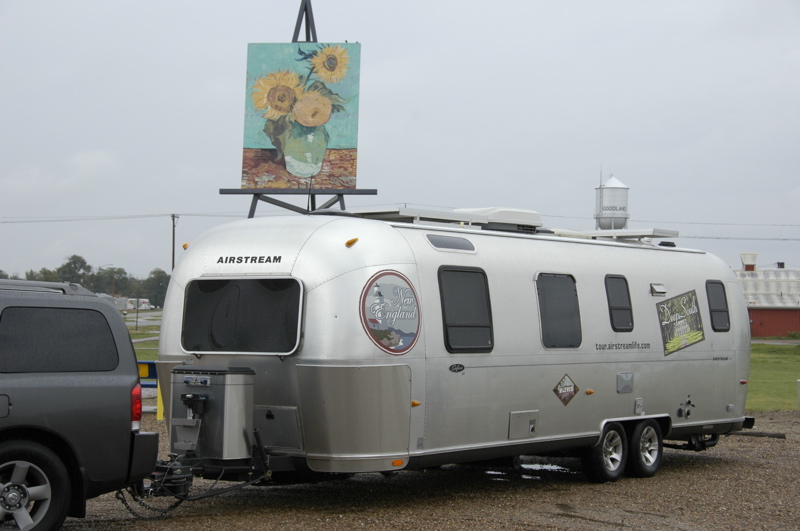
Tourist attraction: The giant Van Gogh reproduction in Goodland KS
Maintenance report: I think there is something wrong with the auto-leveling system on the Armada. It has a factory-installed airbag suspension in the rear, but it appears to have a slow leak. We’ll check that in Denver at a Nissan dealer.
Solar report: We’ve been running on battery since we left Jackson Center, with all three fans running all night and lots of light and water pump usage. We haven’t been frugal with our power at all because there has been abundant sunshine to recharge the batteries. This afternoon the batteries were at 81%, not bad. It’s summertime and the livin’ is easy … on solar power.
« Previous entries ·
Next entries »













